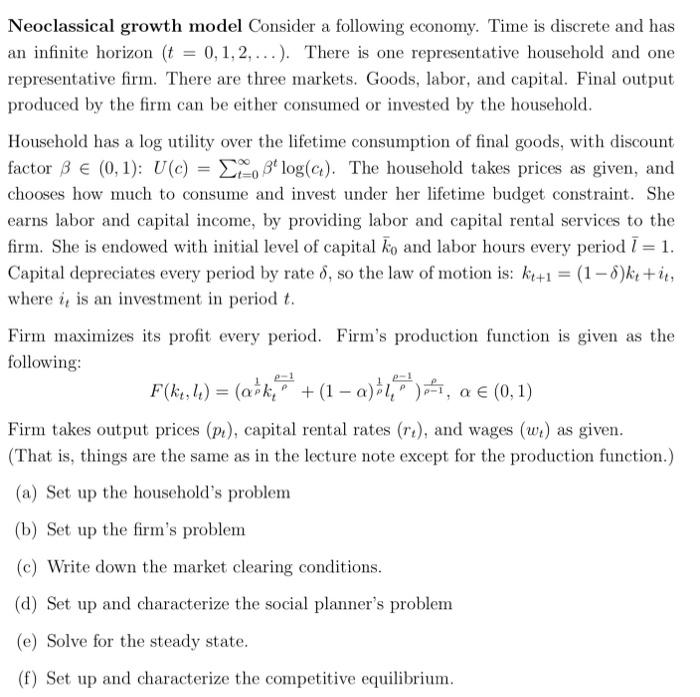Neoclassical growth model Consider a following economy. Time is discrete and has an infinite horizon (t=0,1,2,). There is one representative household and one representative firm. There are three markets. Goods, labor, and capital. Final output produced by the firm can be either consumed or invested by the household. Household has a log utility over the lifetime consumption of final goods, with discount factor (0,1):U(c)=t=0tlog(ct). The household takes prices as given, and chooses how much to consume and invest under her lifetime budget constraint. She earns labor and capital income, by providing labor and capital rental services to the firm. She is endowed with initial level of capital k0 and labor hours every period l=1. Capital depreciates every period by rate , so the law of motion is: kt+1=(1)kt+it, where it is an investment in period t. Firm maximizes its profit every period. Firm's production function is given as the following: F(kt,lt)=(1kt1+(1)1lt1)1,(0,1) Firm takes output prices (pt), capital rental rates (rt), and wages (wt) as given. (That is, things are the same as in the lecture note except for the production function.) (a) Set up the household's problem (b) Set up the firm's problem (c) Write down the market clearing conditions. (d) Set up and characterize the social planner's problem (e) Solve for the steady state. (f) Set up and characterize the competitive equilibrium. Neoclassical growth model Consider a following economy. Time is discrete and has an infinite horizon (t=0,1,2,). There is one representative household and one representative firm. There are three markets. Goods, labor, and capital. Final output produced by the firm can be either consumed or invested by the household. Household has a log utility over the lifetime consumption of final goods, with discount factor (0,1):U(c)=t=0tlog(ct). The household takes prices as given, and chooses how much to consume and invest under her lifetime budget constraint. She earns labor and capital income, by providing labor and capital rental services to the firm. She is endowed with initial level of capital k0 and labor hours every period l=1. Capital depreciates every period by rate , so the law of motion is: kt+1=(1)kt+it, where it is an investment in period t. Firm maximizes its profit every period. Firm's production function is given as the following: F(kt,lt)=(1kt1+(1)1lt1)1,(0,1) Firm takes output prices (pt), capital rental rates (rt), and wages (wt) as given. (That is, things are the same as in the lecture note except for the production function.) (a) Set up the household's problem (b) Set up the firm's problem (c) Write down the market clearing conditions. (d) Set up and characterize the social planner's problem (e) Solve for the steady state. (f) Set up and characterize the competitive equilibrium







